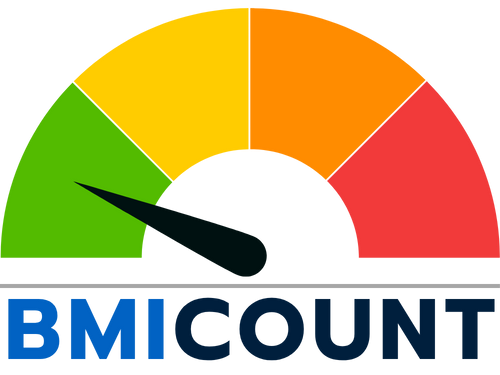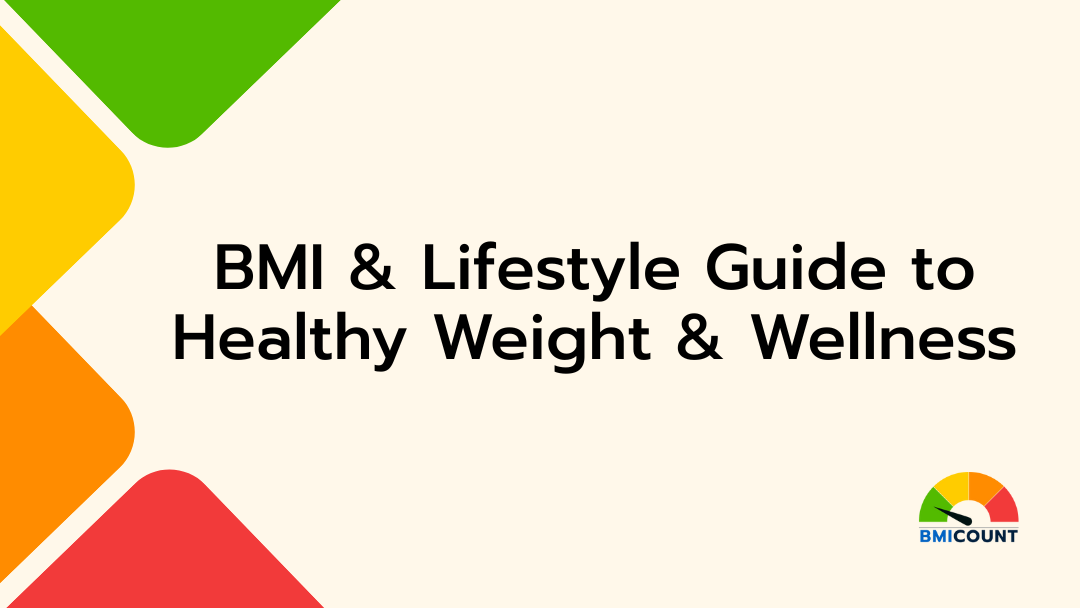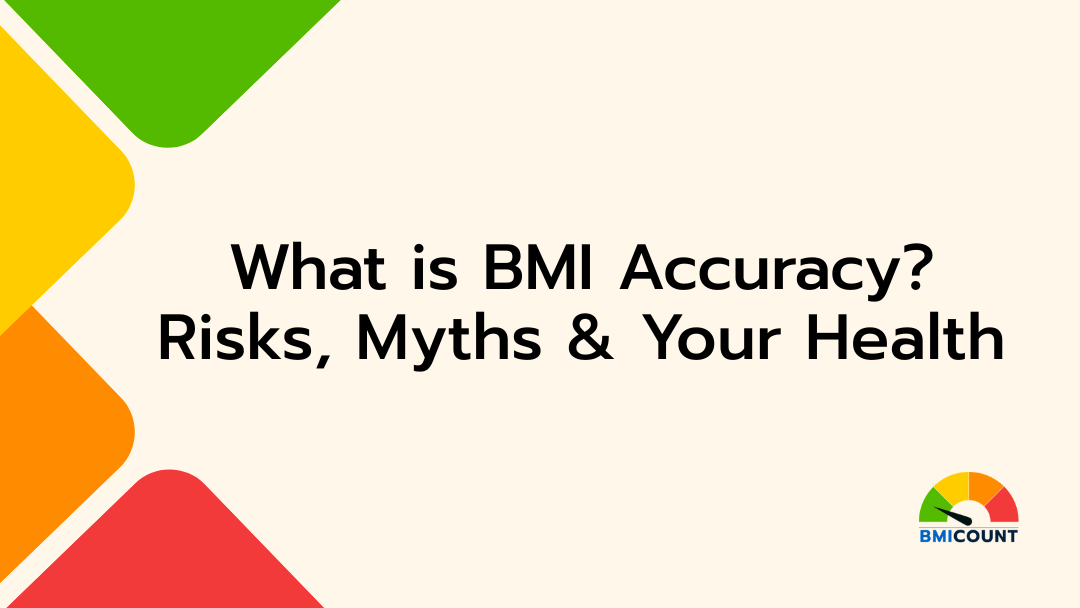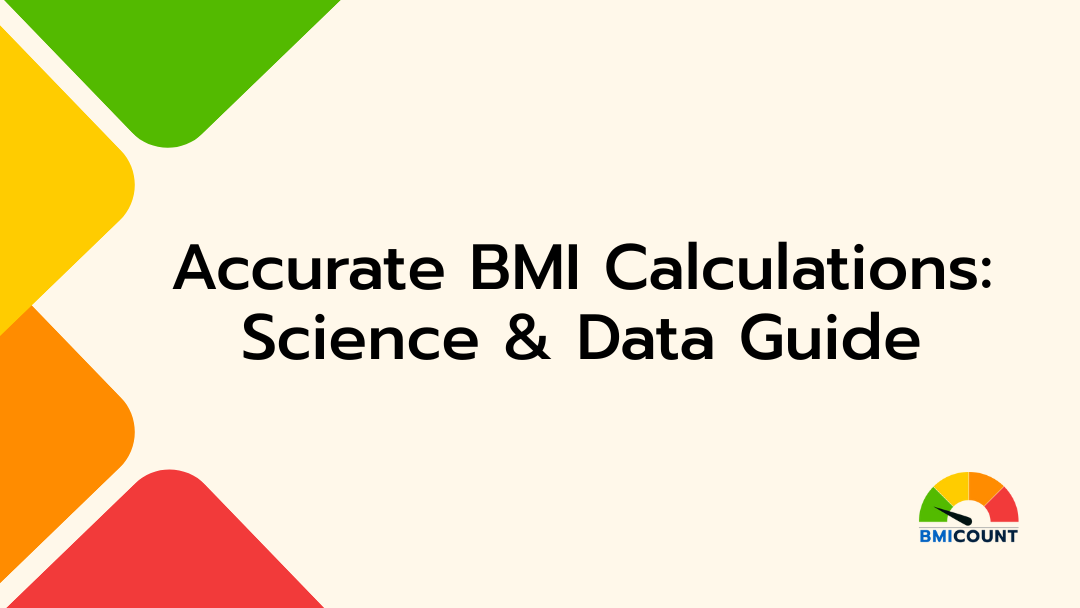You’ve heard the term BMI Calculator, BMI or Body Mass Index everywhere. It’s mentioned at the doctor’s office, splashed across fitness headlines, and debated endlessly online. But for something so common, what does that single, often intimidating number truly mean for your unique health journey?
The problem is, most online BMI calculators offer a dead end. You enter your details and get a number with a generic label: “underweight,” “healthy,” or “overweight.” There’s no context, no nuance, and certainly no clear path forward. It can leave you feeling more confused than when you started, or worse, feeling judged by a number that doesn’t tell your whole story.
We believe you deserve a better answer.
At BMI Count, our mission is to make health information clear, accessible, and, most importantly, complete. This guide and our entire suite of specialized tools is built on that principle. We’re here to demystify and Understand BMI, moving beyond the single number to help you see a more complete picture of your health. And we do it with tools that are always free, require no sign-ups, and deliver accurate, advanced results based on global health standards.
By the end of this guide, you will not only understand BMI inside and out, but you will also know how to use it as a practical starting point for improving your health, no matter your age.
“BMI is a good starting point for assessing the overweight and obesity levels in a population, but it is not a diagnostic tool for an individual’s health.”
Adapted from guidance by the World Health Organization (WHO) & CDC (Centers for Disease Control and Prevention)
What is BMI Calculator and How is it Calculated?
At its core, Body Mass Index (BMI) is a simple mathematical calculation used as a screening tool to gauge a person’s weight category relative to their height. Think of it as a quick, initial snapshot, not a complete medical diagnosis.
The Curious History of BMI: From Astronomer to Health Metric
To Understand BMI story actually begins not in a doctor’s office, but with a Belgian mathematician, astronomer, and statistician named Adolphe Quetelet. In the 1830s, Quetelet was fascinated by human characteristics and was trying to define the “average man” based on various measurements. He developed a formula to describe body mass relative to height, which he called the “Quetelet Index.” His intention was never to measure individual body fat or health, but rather to analyze population trends and growth patterns.
It wasn’t until the mid-20th century that the index found its way into health discussions. In 1972, American physiologist Ancel Keys, a leading researcher in diet and health, formally named it the “Body Mass Index” (BMI). Keys and his team found strong correlations between BMI and the risk for certain metabolic diseases and weight-related health problems on a population level. They recognized its simplicity and cost-effectiveness as a tool for large-scale epidemiological studies and public health screening.
This is precisely why it’s used by organizations like the World Health Organization (WHO) and the Centers for Disease Control and Prevention (CDC) today. It’s an inexpensive, non-invasive, and incredibly easy-to-use method for an initial assessment of potential health risks when looking at large groups of people. It helps public health officials track trends, identify at-risk populations, and allocate resources effectively.
The Standard BMI Formula Explained
The magic of a good BMI calculator is that it handles the math for you instantly. But to truly understand what you’re measuring, it helps to see what’s happening behind the scenes. There are two common formulas, depending on whether you use the metric or imperial system:
- Metric Formula: BMI=textweight(kg)/[textheight(m)]2
- Example: If you weigh 70 kg and are 1.75 m tall: $BMI = 70 / (1.75 \* 1.75) = 70 / 3.0625 \\approx 22.86$
- Imperial Formula: $BMI = [\\text{weight (lbs)} / [\\text{height (in)}]^2] \* 703$
- Example: If you weigh 150 lbs and are 67 inches tall: $BMI = [150 / (67 \* 67)] \* 703 = [150 / 4489] \* 703 \\approx 0.0334 \* 703 \\approx 23.49$
Again, you don’t need to do this yourself. Our tools provide an instant, accurate calculation, and advance results for Men, Women, Kids, Teens and also for Senior Adults so you can focus on what the number means for your health.
The Standard BMI Categories for Adults (WHO)
Once calculated, the BMI number is used to place an adult into one of the following general categories. It’s important to remember that these are broad classifications and, as we’ll explore, they don’t tell the whole story.
| BMI Range | Category |
| Below 18.5 | Underweight |
| 18.5 – 24.9 | Healthy Weight |
| 25.0 – 29.9 | Overweight |
| 30.0 and Above | Obesity |
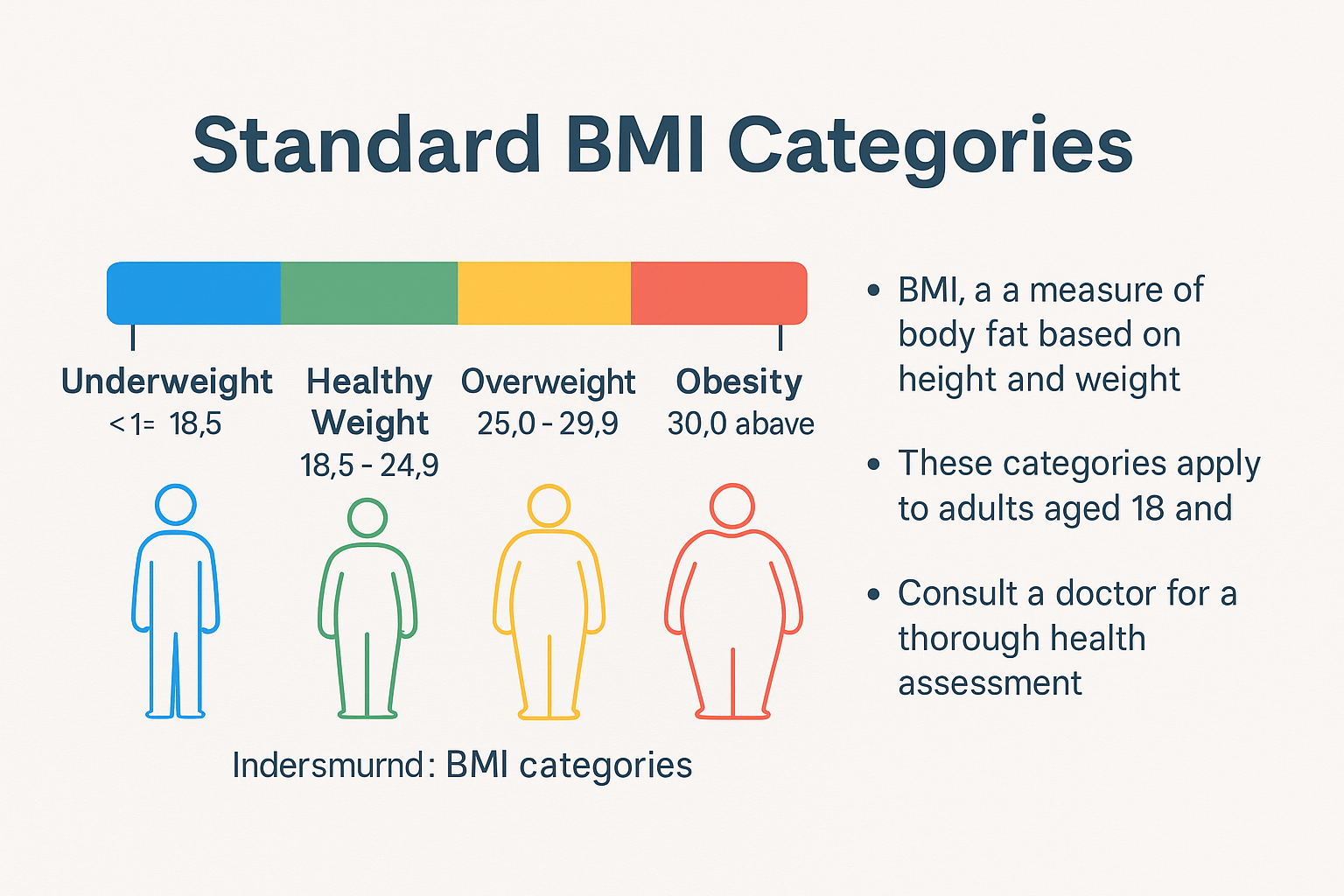
These categories are a solid starting point for most adults, but they are far from the end of the story. The context changes dramatically depending on age, sex, and body composition. Let’s tackle the biggest debate about BMI head-on.
The “Big Debate”: Understanding the Strengths and Limitations of BMI
To use any tool effectively, you must understand BMI what it can do and what it cannot do. BMI is no exception. In the world of health and fitness, it’s one of the most debated metrics, and for good reason. Acknowledging its flaws isn’t a weakness; it’s the first step toward using it intelligently and for your benefit.
Why Should You Understand BMI and Limitations of BMI and its Widely Used Metric
Despite its limitations of BMI, BMI Calculator or Tool has remained a global standard for powerful, practical reasons:
- Accessibility & Simplicity: This is its greatest strength. All you need is a person’s height and weight. No expensive equipment, no complex training, non invasive procedures. This makes it incredibly easy to use in clinics, schools, and even at home.
- Cost-Effectiveness: Because it’s so simple to calculate, it’s virtually free. This makes it an invaluable public health tool for screening large populations, especially in low-resource settings, allowing public health officials to get a broad overview of weight status without significant financial investment.
- Strong Population-Level Correlation: For the average individual, particularly those who are not athletes or have unusual body compositions, a high BMI is indeed very often correlated with higher levels of body fat. This increased body fat, in turn, is linked to an elevated risk for a host of chronic conditions such as type 2 diabetes, cardiovascular disease, certain cancers, sleep apnea, and high blood pressure. It serves as a useful flag for potential health risks on a population scale, guiding public health interventions and research. The National Institutes of Health (NIH) provides extensive research linking BMI to various health outcomes.
- Historical Data & Consistency: Because it has been used for so long, there’s a vast amount of historical data linked to BMI, allowing researchers to track obesity trends over decades and compare health outcomes across different studies and populations consistently.
Acknowledging the Limitations of BMI: What BMI Doesn’t Tell You
This is where context becomes king. BMI, by itself, completely ignores several critical pieces of information that are vital for a true understanding of an individual’s health:
- It Doesn’t Distinguish Between Muscle and Fat: This is arguably BMI’s most famous flaw. Muscle is significantly denser than fat (it takes up less space for the same weight).
- Imagine this scenario: A professional rugby player, incredibly muscular and lean, might have a BMI that classifies them as “overweight” or even “obese” simply because of their high muscle mass. Yet, they could have very low body fat and excellent cardiovascular health.
- Conversely: A sedentary individual of the same height and weight might have less muscle and a higher percentage of body fat, putting them at higher health risk, yet they could have a similar or even lower BMI than the athlete. The number doesn’t tell the story of their body’s true composition.
- It Doesn’t Account for Body Composition Beyond Mass: This goes hand-in-hand with the muscle vs. fat issue. BMI provides a ratio of total weight to height, but it offers no insight into what that weight is made of.
- Consider an inactive older adult: They might have a “healthy” BMI, but due to years of inactivity and natural aging, they could have lost significant muscle mass while gaining visceral fat (the dangerous fat around organs). This condition is known as sarcopenic obesity. Their BMI score would be misleadingly reassuring, completely masking a significant health risk like frailty and metabolic issues.
- It Doesn’t Consider Fat Distribution: Not all fat is created equal. Visceral fat, which accumulates around your internal organs in the abdominal cavity, is far more metabolically active and dangerous than subcutaneous fat (the jiggly fat just under your skin). Visceral fat is strongly linked to insulin resistance, inflammation, and an increased risk of heart disease and type 2 diabetes. BMI has no way of knowing this crucial difference.
- A valuable complementary tool: While BMI doesn’t tell you about fat distribution, a simple waist circumference measurement can provide crucial insight into abdominal obesity and visceral fat levels, even for individuals with a “healthy” BMI. The CDC provides guidance on measuring waist circumference as a complementary screening tool.
- It May Not Apply Uniformly Across Different Ethnicities: Emerging research strongly suggests that the standard BMI cut-offs may not be universally applicable across all ethnic groups. For instance, some Asian populations may have a higher risk of type 2 diabetes and cardiovascular disease at lower BMIs compared to Caucasian populations. This is often due to differences in body composition and fat distribution patterns (e.g., a tendency to carry more visceral fat at lower overall body weights). The WHO has acknowledged these differences and, in some regions, recommends different BMI action points for various populations. Applying a one-size-fits-all approach can lead to misclassification and potentially delayed health interventions for these groups.
- It Doesn’t Consider Life Stages or Age: As we’ll delve into in later chapters, a “healthy” BMI for a growing child is interpreted via percentiles, not fixed numbers. For seniors, a slightly higher BMI can actually be protective, and the focus shifts significantly from weight loss to muscle preservation.
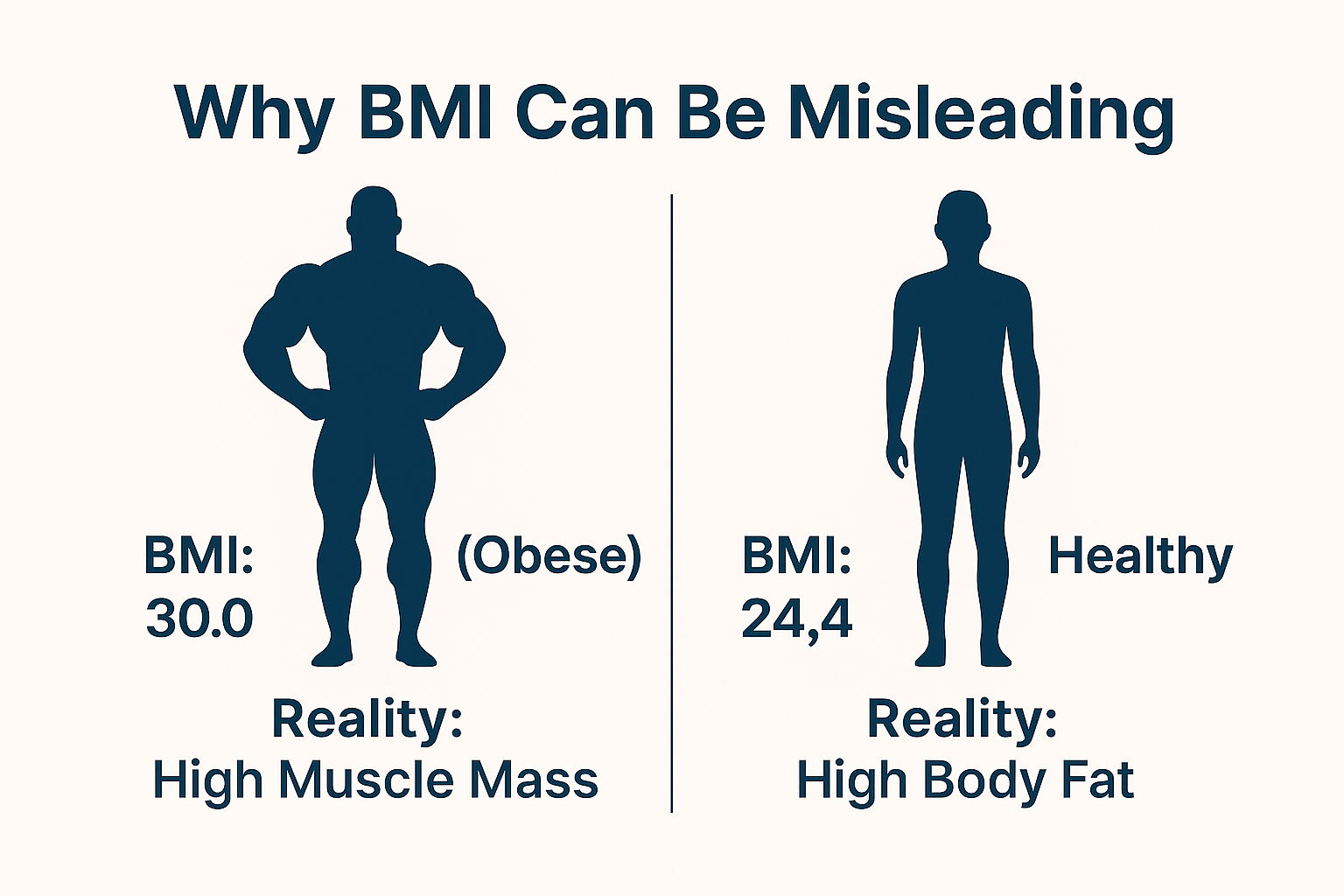
So, if BMI is so flawed, should we throw it out completely? No. We believe it should be used as it was intended: as a starting point for a conversation about your health, a tool that prompts further investigation, not a definitive diagnosis. It’s one piece of a much larger, more intricate health puzzle.
Chapter 1: BMI for Adults (Men & Women, 18-60)
This is the demographic for which the standard BMI Calculator or BMI chart is most commonly applied. For the majority of adults, BMI serves as a solid initial screening tool, providing a quick assessment of whether their weight falls into a range generally associated with lower health risks. But even here, the basic number is just the beginning of the story.
For adults aged 18 to 60, the WHO categories (underweight, healthy weight, overweight, obesity) are the primary reference. However, the beauty of moving beyond a generic BMI calculator lies in gaining a richer understanding of what your number implies and what actionable steps you can take.
Go Beyond the Number: Your Adult BMI Results on BMI Count
After you get your standard BMI score on BMI Count, we immediately give you more context. Here’s a breakdown of the free, advanced insights you’ll receive, helping you interpret your results with greater precision:
- Ideal Weight Range: This transforms an abstract category into a tangible goal. Instead of just “healthy weight,” we show you the specific weight range for your height that corresponds to the “healthy” BMI zone (18.5-24.9). This provides a clear, actionable target, giving you a tangible idea of what a healthy weight looks like for your body. It’s not about hitting a single, rigid number, but understanding the spectrum within which your body is generally considered to be at its lowest risk for weight-related health issues.
- Body Surface Area (BSA):
- What it is: A measurement of the total surface area of your body, expressed in square meters (m2). It takes into account both your weight and height.
- Why it Matters Clinically: BSA is a critical metric in many medical settings, especially for precise medication dosages. Doctors use it to calculate the exact amounts of certain drugs, like chemotherapy agents, to ensure maximum effectiveness with minimal side effects. It’s also used to determine fluid needs for burn victims and in various other clinical calculations related to metabolism and physiology. For instance, the National Cancer Institute (NCI) often references BSA in its guidelines for chemotherapy dosing. While you won’t use it daily, knowing your BSA gives you a more scientific view of your body metrics, similar to what’s used by healthcare professionals for personalized treatment. It’s a testament to the intricate calculations your body requires.
- Caloric Needs (Kcal) to Maintain Weight (Total Daily Energy Expenditure – TDEE): This powerful feature estimates the daily calories your body needs to maintain its current weight. This number represents your Total Daily Energy Expenditure (TDEE), which is the sum of:
- Basal Metabolic Rate (BMR): The calories your body burns at rest just to perform basic life-sustaining functions (breathing, circulation, cell production).
- Thermic Effect of Food (TEF): The calories burned during digestion and absorption of food.
- Activity Level: The calories burned during physical activity and non-exercise movement. This number is your key to understanding energy balance and empowers you to make informed decisions about your nutrition. If you want to lose weight, you’ll generally need to consume slightly fewer calories than your TDEE. If you aim to gain weight (e.g., muscle mass), you’ll need a slight caloric surplus. Understanding your TDEE is the foundation for any weight management strategy, helping you to create a sustainable plan.
Ready to see beyond the single number? Calculate your BMI with BMI Count or get specific insights with the BMI Calculator for Men or BMI Calculator for Women to unlock your free, advanced results instantly.
Chapter 2: A Different Approach: BMI for Kids and Teens (2-17)
Applying the adult BMI chart to children and adolescents is fundamentally incorrect and unhelpful. Kids and teens are in a constant state of growth and development, which profoundly impacts their body composition. Therefore, instead of a fixed BMI number, healthcare professionals use BMI-for-age percentiles for Checking BMI for kids and teens, which compare a child’s BMI to others of the same age and sex.
Understanding Growth, Puberty, and Percentiles
A child’s growth is not a straight line it comes in spurts, particularly during infancy and adolescence. Puberty, in particular, causes rapid and dramatic changes in height, weight, and body composition. For instance, boys typically experience a significant increase in muscle mass, while girls often see an increase in body fat distribution to different areas. These temporary shifts can cause the BMI for kids and teens to fluctuate in percentile, which is a normal part of development.
This is precisely why tracking the trend over several months or years is far more important than any one reading. A BMI for Kids and Teens percentile might jump or dip temporarily during a growth spurt, but a stable percentile trend is generally a good sign of healthy development. Conversely, a percentile that is rapidly increasing or decreasing, or one that consistently falls outside the healthy range, is a good reason to check in with a pediatrician. It’s about the pattern of growth, not a single snapshot in time.
- How Percentiles Work: When you use a BMI-for-age percentile BMI calculator, your child’s BMI is plotted on a growth chart that shows the distribution of BMI for children of the same age and sex. The CDC provides detailed growth charts that pediatricians use to track development.
- Below the 5th percentile: Underweight
- 5th percentile to less than the 85th percentile: Healthy weight
- 85th percentile to less than the 95th percentile: Overweight
- Equal to or greater than the 95th percentile: Obesity This approach ensures that a child’s natural growth trajectory is accounted for, providing a more accurate assessment of their weight status relative to their peers.
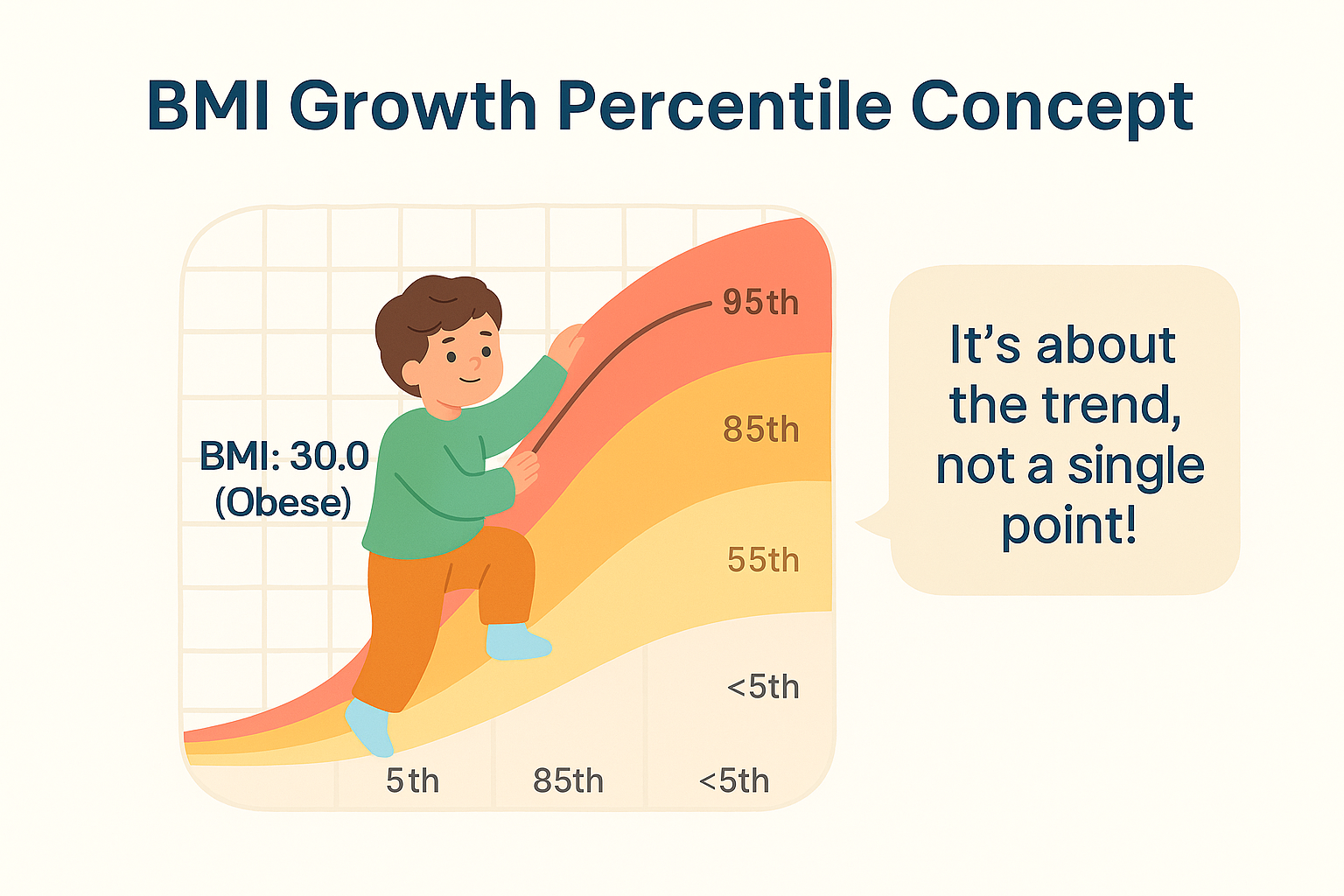
Our Gentle, Action-Oriented Guidance to Understand BMI for Kids and Teens
A child’s or teen’s health is a sensitive topic, and it’s crucial to approach it with support and understanding, not judgment or anxiety. Our goal at BMI Count is to empower parents with information, not to create stress. That’s why our guidance for children and teens focuses on positive, sustainable habits for the entire family:
- Focus on Balanced Meals, Not Restriction: We reframe the conversation around nourishment and health, not “dieting” or calorie counting, which can be detrimental for developing bodies and minds. Encourage a wide variety of fruits, vegetables, lean proteins, and whole grains. Involve children in meal preparation to foster a positive relationship with food. The MyPlate guidance from the USDA offers excellent, accessible advice for balanced eating.
- Incorporate More Movement & Play, Not Grueling Exercise: Physical activity should be fun and integrated into daily life. Encourage active play, outdoor adventures, family walks or bike rides, and participation in sports or dance classes. The emphasis is on joyful movement, not structured, intense workouts that might feel like a chore. The CDC’s recommendations for physical activity for children and adolescents are a great resource.
- Gentle Guidance & Professional Consultation: We provide simple, reassuring text that explains the percentile in an easy-to-understand way. Crucially, we always advise consulting a healthcare provider (pediatrician or family doctor) for personalized advice. They can consider a child’s full medical history, family health, and individual growth patterns to provide the most appropriate recommendations.
Support your child’s healthy development with a tool designed specifically for them. Use the BMI Calculator for Kids (2-12) or BMI Calculator for Teens (13-17) for responsible, percentile-based tracking and gentle guidance.
Chapter 3: Redefining Healthy: BMI for Senior Adults (60+)
As we age, the rules of BMI shift again, reflecting the unique physiological changes and health priorities of later life. For seniors, a slightly higher BMI than the “normal” adult range can often be protective, providing a valuable buffer against illness and weight loss associated with health challenges. The biggest health risk in this age group is often not excess weight, but rather the loss of vital muscle mass, a condition known as sarcopenia.
Sarcopenia: The Hidden Risk in Aging
Sarcopenia is the age-related, progressive loss of muscle mass and strength. It’s a silent threat that can significantly impact quality of life for seniors, leading to:
- Increased Frailty: Making everyday tasks like walking, climbing stairs, or carrying groceries challenging.
- Higher Risk of Falls and Fractures: Weakened muscles reduce stability and balance, making falls more likely and their consequences more severe. The NIH’s National Institute on Aging emphasizes the importance of strength for fall prevention.
- Reduced Metabolic Health: Muscle is metabolically active. Its loss can impair insulin sensitivity, making it harder for the body to regulate blood sugar, and potentially contributing to type 2 diabetes.
- Weakened Immune System: Muscle plays a role in immune function, and sarcopenia can make seniors more susceptible to infections.
- Decreased Quality of Life: The loss of independence and ability to participate in enjoyable activities due to muscle weakness.
A low or rapidly declining BMI in a senior can be a red flag for sarcopenia, indicating an unhealthy loss of protective muscle mass rather than beneficial fat. While BMI doesn’t directly measure muscle, a surprising drop in BMI, or a BMI that is consistently at the lower end of the “healthy” range or below, warrants investigation for sarcopenia.

Proactive Steps: Fighting Sarcopenia and Maintaining Vitality
The focus for seniors should be on preserving functional strength, promoting vitality, and ensuring adequate nutrition. Two key strategies are paramount:
- Adequate Protein Intake: Seniors often need more protein than younger adults to stimulate muscle protein synthesis (the process of building and repairing muscle). As we age, our bodies become less efficient at utilizing dietary protein for muscle growth. Therefore, focusing on nutrient-rich meals with lean proteins is critical. Aim for sources like lean meats, poultry, fish, eggs, dairy products (milk, yogurt, cheese), legumes (beans, lentils), and tofu. The National Institute on Aging provides excellent resources on healthy eating for seniors. Spreading protein intake throughout the day can also be beneficial.
- Resistance Training (Strength Training): This doesn’t mean becoming a bodybuilder. Gentle, regular resistance exercise is the single most effective way to signal to the body to build and maintain muscle mass. Examples include:
- Using light weights or resistance bands.
- Bodyweight exercises like chair squats (standing up and sitting down from a chair), wall push-ups, or calf raises.
- Incorporating functional movements that mimic daily activities. The key is consistency and gradual progression, even if it’s just 15-30 minutes, 2-3 times a week. The CDC’s guidance on physical activity for older adults emphasizes balance and strength training. Always consult with a doctor or physical therapist before starting any new exercise program, especially if you have existing health conditions.
Our Senior BMI Calculator supports this goal by focusing guidance on “Nutrient-Rich Meals” and “Gentle, Regular Movement,” aligning with the specific health needs of older adults. It prioritizes maintaining strength and vitality over strict weight loss.
Proactively manage your health in your golden years. Get a nuanced perspective with our BMI Calculator for Senior Adults.
At a Glance: How BMI Interpretation Changes With Age
To make it crystal clear, here’s how the goal and interpretation of BMI differ across the three main life stages. This table highlights why a single, universal BMI category simply doesn’t cut it.
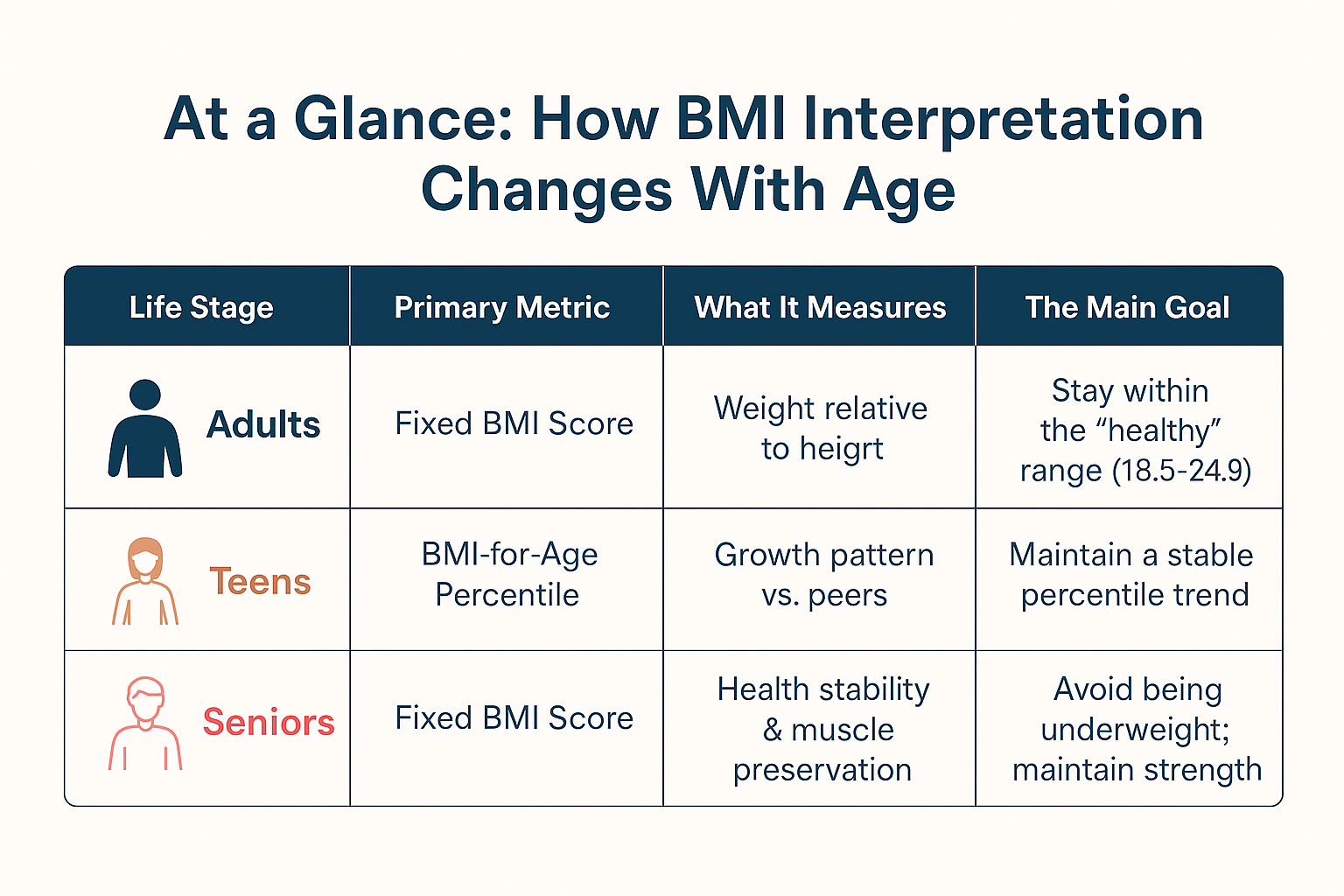
| Life Stage | Primary Metric | What It Measures | The Main Goal |
| Adults (18-60) | Fixed BMI Score | Weight relative to height | Stay within the “healthy” range (18.5-24.9) |
| Kids/Teens (2-17) | BMI-for-Age Percentile | Growth pattern vs. peers | Maintain a stable percentile trend |
| Seniors (60+) | Fixed BMI Score | Health stability & muscle preservation | Avoid being underweight; maintain strength and vitality |
Going Beyond the Number: Understanding Your Advanced Results
At BMI Count, we empower you with more than just a single, isolated number. Our comprehensive tools provide a deeper look at your body metrics, offering valuable insights that go beyond standard BMI categories. These advanced results are calculated instantly and are always free, giving you a more complete picture of your health.
Here’s a closer look at the powerful metrics you’ll receive and why they matter:
1. Ideal Weight Range
While your standard BMI calculation places you in a category like “overweight” or “healthy weight,” our Ideal Weight Range result provides a much more practical and actionable goal. This range shows you the specific weight values, in kilograms or pounds, that correspond to the “healthy weight” BMI category (18.5-24.9) for your particular height.
Why it matters:
- Tangible Goal: It transforms an abstract concept (“healthy BMI”) into a concrete, measurable target. Instead of aiming for a vague “healthy,” you have a clear weight bracket to work towards.
- Removes Guesswork: You no longer have to guess what a healthy weight looks like for your unique stature.
- Focus on Range, Not Single Number: It emphasizes that there isn’t one “perfect” weight, but rather a healthy spectrum, encouraging flexibility and sustainability in your health efforts.
2. Body Surface Area (BSA)
Body Surface Area is a measurement of the total surface area of your body, usually expressed in square meters (m2). It’s derived from complex formulas that take into account both your weight and height.
Why it matters clinically:
- Precise Medication Dosing: BSA is a critical metric in many medical fields, particularly in oncology and critical care. For powerful drugs like chemotherapy agents, pediatric medications, or certain cardiovascular drugs, dosages are often calculated based on BSA to ensure maximum therapeutic effect while minimizing harmful side effects. This precision is vital because a person’s surface area influences how drugs are absorbed, distributed, and eliminated.
- Fluid Management: In cases of severe burns, doctors use BSA to calculate the precise amount of intravenous fluids needed to prevent dehydration and maintain electrolyte balance, which is crucial for patient survival.
- Metabolic Studies: Researchers use BSA in studies related to metabolism, heat regulation, and physiological processes, as it’s a better indicator of metabolic mass than weight alone.
While you won’t typically use your BSA in daily health management, understanding this metric gives you a glimpse into the sophisticated calculations healthcare professionals use to provide personalized, precise care. It highlights that your body is a complex system requiring nuanced assessment, reinforcing the idea that BMI is just one piece of the puzzle.
3. Caloric Needs (Kcal) to Maintain Weight (Total Daily Energy Expenditure – TDEE)
This powerful feature estimates the daily calories your body needs to maintain its current weight. This figure, often referred to as your Total Daily Energy Expenditure (TDEE), is one of the most fundamental numbers for understanding energy balance and empowering you to make informed decisions about your nutrition.
How it’s calculated: Your TDEE is made up of three main components:
- Basal Metabolic Rate (BMR): The largest component, BMR is the number of calories your body burns at rest to perform essential life-sustaining functions (breathing, circulation, organ function, cell production).
- Thermic Effect of Food (TEF): The calories expended during the digestion, absorption, and storage of food. This accounts for about 5-10% of your total daily energy expenditure.
- Activity Level: The calories burned through physical activity, from structured exercise to daily non-exercise movement (walking, standing, fidgeting).
Why it matters for you:
- Foundation for Weight Management: Knowing your TDEE is the starting point for any weight goal.
- If you aim to lose weight, you’ll generally need to create a sustainable caloric deficit by consuming slightly fewer calories than your TDEE (e.g., 250-500 calories less per day for a gradual, healthy loss of 0.5-1 kg per week).
- If you aim to gain weight (e.g., muscle mass), you’ll need a slight caloric surplus.
- If you want to maintain your current weight, consuming roughly your TDEE will help you do so.
- Informed Nutrition Decisions: It empowers you to make conscious choices about your food intake, helping you understand the “why” behind dietary recommendations. It provides a baseline for tracking and adjusting your energy intake to align with your health objectives.
- Understanding Energy Balance: It helps you grasp the fundamental concept of energy balance: calories in vs. calories out. While simplified, it’s a crucial principle for managing body weight over the long term.
By providing these advanced results, BMI Count moves beyond a simple classification, giving you the detailed, actionable information needed to understand your body better and take control of your health journey.
How to Use Your BMI Results: Actionable Next Steps
Turning your results into a positive, proactive plan is the most important step. Remember, your BMI is a starting point for a conversation – with yourself, and ideally, with a healthcare professional. It’s a tool for awareness, not a definitive verdict.
If You Are in the “Underweight” Range…
Being underweight can sometimes carry health risks, including nutrient deficiencies, weakened immune function, decreased bone density, and fatigue.
- Focus on Nutrient-Dense Foods: Instead of simply eating more “junk” food, prioritize meals rich in healthy fats, proteins, and complex carbohydrates. Think nuts, seeds, avocados, olive oil, whole grains, lean meats, fish, eggs, dairy, and legumes.
- Consider Strength Training: Building healthy muscle mass can help you gain weight in a beneficial way, improve strength, and support overall health. Consult a certified personal trainer for a safe and effective program.
- Crucially, Consult a Doctor: It’s vital to rule out any underlying medical conditions that might be contributing to your low weight, such as thyroid issues, digestive disorders, or other health concerns. Your doctor can perform necessary tests and provide personalized dietary recommendations.
If You Are in the “Healthy” Range…
Congratulations! This indicates that your weight, relative to your height, is generally associated with a lower risk of weight-related health problems.
- Focus on Maintenance and Consistency: Use this as positive reinforcement for your healthy habits. Keep up the great work with balanced nutrition, regular physical activity, adequate sleep, and stress management.
- Optimize Your Health: Don’t stop here! Continue to explore new forms of exercise, diversify your diet with even more nutrient-rich foods, and focus on holistic well-being. This is an opportunity to refine and enhance your already good habits and maintain vitality for years to come.
If You Are in the “Overweight” or “Obesity” Range…
It’s important to approach these results with self-compassion and a focus on sustainable change, not shame or drastic measures. These categories simply indicate that your weight, relative to your height, may put you at an increased risk for certain health conditions.
- Focus on Small, Sustainable Changes: Drastic diets or exercise regimes often lead to burnout. Instead, identify one or two small, achievable changes you can make consistently.
- Utilize Your Kcal Info: Use your estimated Caloric Needs (TDEE) to create a small, daily calorie deficit. A reduction of 250-500 calories per day can lead to a healthy, gradual weight loss of approximately 0.5-1 kg (1-2 pounds) per week. Focus on portion control and opting for whole, unprocessed foods.
- Increase Movement Incrementally: Add a 15-minute walk to your day, take the stairs instead of the elevator, or try a new active hobby. Consistency trumps intensity initially. The NIH’s National Heart, Lung, and Blood Institute offers practical tips for increasing activity.
- Swap Sugary Drinks for Water: This is often one of the easiest and most impactful changes for reducing empty calories.
- Prioritize Sleep and Stress Management: These often overlooked factors play a significant role in weight regulation, hormone balance, and overall health.
- Seek Professional Guidance: Use this result as a motivator, not a source of shame. The most effective and safest way to address being overweight or obese is to speak with a qualified healthcare professional.
- Your Doctor: Can assess your overall health, identify any coexisting conditions (like high blood pressure or diabetes), and help you create a safe, personalized plan.
- Registered Dietitian (RD): Can provide tailored nutrition advice, helping you develop a sustainable eating plan that fits your lifestyle, preferences, and health needs. Find an RD through organizations like the Academy of Nutrition and Dietetics.
- Certified Personal Trainer: Can design a safe and effective exercise program that matches your fitness level, goals, and any physical limitations. Look for certifications from reputable bodies like the American Council on Exercise (ACE) or the National Academy of Sports Medicine (NASM).
CRITICAL DISCLAIMER: This guide is for educational purposes only. BMI is a screening tool, not a diagnosis. Always consult a qualified healthcare provider (doctor, registered dietitian, certified personal trainer) before making any significant changes to your diet or exercise routine, especially if you have existing health conditions. They can provide personalized advice based on your complete health profile.
Implications of BMI Categories
Understanding your BMI category is the first step. To learn how to effectively apply this knowledge through diet, exercise, and healthy habits to support your overall well-being, explore our detailed guide on BMI and lifestyle changes.
Frequently Asked Questions
How often should I check my BMI?
For most adults, checking your BMI once every few months (e.g., quarterly) is more than enough. Weight can fluctuate daily due to water retention, hydration levels, food intake, and other factors, so tracking it too frequently can be misleading and lead to unnecessary anxiety. The goal is to monitor the long-term trend, not daily variations. For children and teens, a pediatrician will typically track BMI percentiles during regular check-ups, as recommended by the CDC.
Can I be fit and still have a high BMI?
Absolutely, yes! This is the classic “athlete problem” and one of the primary limitations of BMI. If you have significant muscle mass, your weight will naturally be higher because muscle is denser than fat. This can easily push your BMI into the “overweight” or even “obesity” category, even if you have a very low body fat percentage, excellent cardiovascular health, and high physical fitness.
What is the most accurate way to measure body fat?
The most accurate methods for measuring body fat are clinical procedures. These include:
- DEXA Scan: Precise measurement of bone, fat, and lean mass.
- Hydrostatic Weighing: Measures body density using water displacement.
Accessible options include:
- Skinfold Calipers: Measure fat under the skin.
- BIA Scales: Estimate fat using electrical impedance (accuracy varies).
Why do I need to enter my age and sex for a BMI calculation on BMI Count?
While the BMI formula only needs height and weight, interpreting results accurately requires age and sex. BMI ranges vary significantly across life stages:
- Children/Teens: Percentile-based interpretation (CDC).
- Adults: Standard fixed categories.
- Seniors: Focus on vitality and muscle mass preservation.
Does BMI account for bone density?
No. BMI does not factor in bone density. While bone weight can vary slightly between individuals, BMI’s primary weakness is its inability to differentiate between fat and muscle, not bone mass.
What about very tall or very short people? Does BMI work for them?
BMI may slightly underestimate fat in very tall people and overestimate it in very short individuals. While it works well for most people, it’s less accurate at height extremes.
Does pregnancy affect BMI interpretation?
Yes. BMI is not a valid health measure during pregnancy. Weight gain during pregnancy is normal and guided by healthcare providers based on pre-pregnancy BMI, not typical adult standards.
Why is your BMI calculator really free? What’s the catch?
There is no catch. Our calculator and tools are 100% free with no hidden costs, no sign-ups, and no data selling. We believe in open access to health tools that empower users.
Conclusion: Your Health Journey, Empowered by Information
The journey to understanding your health can often feel overwhelming, riddled with confusing numbers and conflicting advice. We hope this guide has helped cut through the noise and demystify one of the most common—and most misunderstood—metrics in health: the Body Mass Index.
We’ve learned that BMI is not a final judgment, nor is it a perfect diagnostic tool. Instead, it is a valuable starting point for a deeper exploration of your well-being. A number alone is often useless, but a number combined with:
- An understanding of its limitations,
- Context for your specific life stage (adult, child, senior),
- Complementary metrics like ideal weight range and caloric needs, and
- Actionable next steps…
…becomes a powerful tool for empowerment.
That is our entire philosophy at BMI Count. We don’t just give you a number; we provide the context, the nuance, and the additional insights you need to truly understand what your BMI means for you. Whether you’re a young adult tracking your fitness, a parent guiding your child’s healthy growth, or a senior focusing on vitality and muscle preservation, our tools are designed to give you a complete health picture, not just a single number.
Your health journey is uniquely yours. We’re just here to provide a better, clearer map, free of charge and full of valuable insights. Take the next step in understanding your health today.
Now that you have a comprehensive understanding of BMI, its strengths, and its limitations, the next step is to explore how you can proactively manage your health and well-being. Dive deeper into actionable strategies for improving your body composition and vitality with our ultimate guide to BMI and lifestyle management.
